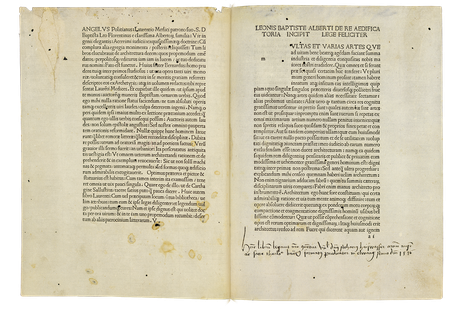
Ancient Sources and New Experiences <
By nature, all good humans have a thirst for knowledge
Leonardo da Vinci
Codex Atlanticus, fol. 327v. Translation: Elizabeth Hughes
In the 15th century, scholars throughout Europe, especially in Italy, sought to raise knowledge of and familiarity with authors from ancient Greece and Rome to a new level. The goal of these humanists was to collect textual sources systematically from widely diverse fields of knowledge and make them accessible through commentaries, translations, and soon through printed editions as well. Encyclopedias such as those by the philologist and mathematician Giorgio Valla (ca. 1447–1499) made previously rare handwritten treatises generally available.
Florence was the first center of this movement, which was celebrated as the rebirth (Rinascita or Rinascimento in Italian, Renaissance in French) of ancient culture. The ideal of antiquity rapidly penetrated and inspired every cultural area, such as literature, architecture, and the visual arts. Parallel to this, the study of ancient traditions also promised resources for solving technical and scientific problems and tasks of contemporary life. Ancient natural scientists such as the Greek mathematicians Archimedes (ca. 287–212 BCE), Ptolemy (ca. 100–160 CE), and Euclid (ca. 300 BCE) were important authorities whose extant works formed a fixed canon. Their achievements also inspired Renaissance scholars in their own research and further observations.
Another canonical work is the Ten Books on Architecture by the Roman architect and engineer Vitruvius (ca. 70 BCE–ca. 15 CE). Its impact can hardly be overestimated and Leonardo da Vinci naturally owned an edition.
A contemporary counterpart are the writings of the philologist, master builder, and art theorist Leon Battista Alberti (1404–1472). His architectural designs, like those for the façade of Santa Maria Novella in Florence, are considered incunabula of Renaissance architecture, while his writings on the genres of architecture, painting, and sculpture laid down the first theoretical basis for the new forms of design. The humanist Alberti was regarded by his contemporaries as a shining example of universal education. He was an inspiration for Leonardo, too, not least for the latter’s own theoretical writings on painting.
Leonardo's Berlin Library: Section 4 <
 | 33.
Florence: Nicolaus Laurentii, 1485 |

The manuscript De re aedificatoria by Leon Battista Alberti was presented to Pope Nicholas V in 1452, the year Leonardo da Vinci was born. It was printed for the first time in 1485, while the first printed edition of Vitruvius’ De architectura appeared in the following year. In his book lists, Leonardo referred to Alberti’s De re aedificatoria as batista alberti in architettura (3 ▲). Alberti’s treatise on architecture which, like that of Vitruvius, consists of ten books, profoundly influenced architects and their patrons in the Renaissance. De re aedificatoria forms a trilogy together with two other works by Alberti: De pictura and De statua. Alberti, who was seen as epitomizing the Renaissance humanist educational ideal, was deeply revered by Leonardo and his contemporaries.
References
Calzona, Arturo, Francesco Paolo Fiore, Alberto Tenenti, and Cesare Vasoli, eds. 2007. Leon Battista Alberti. Teorico delle arti e gli impegni civili del “De re aedificatoria.” 2 vols. Ingenium / Centro di Studi Leon Battista Alberti, Mantova 9. Florence: Olschki.
Cardini, Roberto, ed. 2005. Leon Battista Alberti. La biblioteca di un umanista. Cataloghi e mostre, Centro di studi sul classicismo 6. Florence: Mandragora.
Gerli, Meg. 2019. In Leonardo’s Library. The World of a Renaissance Reader, edited by Paula Findlen. Stanford, CA: Stanford Libraries, 169, no. 37.
Leon Battista Alberti. 2005. Zehn Bücher über die Baukunst (translated into German, introduced, and with notes and drawings by Max Theurer). 2nd unrevised edition (unrevised reprographic reprint of the first edition. 1912. Vienna / Leipzig: Heller). Darmstadt: Wissenschaftliche Buchgesellschaft.









